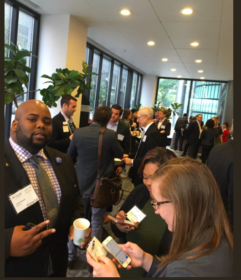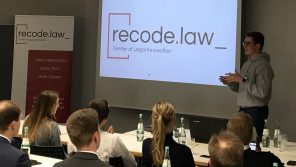2017 Financial Legal Technology Conference at Chicago-Kent College of Law was a high intensity day packed with information from over twenty leaders in the crosshairs of technology in the legal and financial industry. In order to attempt to give a more accurate overview of the day’s events, Jay Evans and I will be releasing a series of posts summarizing some of the main themes we saw throughout the day.
“Innovation means people sitting at the same table, talking the same language, with a common set of goals.”
 “The field of law is moving too [slow],” David Cambria, Global Director of Legal Operations for Archer Daniels Midland. “The law looks like finance 50 years ago” Dan Katz, Director of the Law Lab at Illinois Tech Chicago College of Law. Katz opened the conference with establishing two major branches of Fintech: (1) removing the socially meaningless friction of “that’s the way we have always done something” and (2) how to characterize (price) risk using legal technology. Lawyers tend to think of themselves as risk adverse, but “it is meaningless in business to say something is risky.” Being a lawyer means helping to decide which risk is worth taking. Corporate clients need attorneys who speak their language and who understand their goals. Unfortunately, attorneys have not been properly trained during law school for optimal use by their corporate clients. Throughout the day, the need for law schools to alter their approach to training law students by freeing up the capacity for alternative streams of courses was a reoccurring theme. Lucy Bassli, Assistant General Counsel of Microsoft, spoke on how the traditional education of law and constraints on the unauthorized practice of law is a huge impediment to innovation. Why should educators care? Because they are preparing for their future careers.
“The field of law is moving too [slow],” David Cambria, Global Director of Legal Operations for Archer Daniels Midland. “The law looks like finance 50 years ago” Dan Katz, Director of the Law Lab at Illinois Tech Chicago College of Law. Katz opened the conference with establishing two major branches of Fintech: (1) removing the socially meaningless friction of “that’s the way we have always done something” and (2) how to characterize (price) risk using legal technology. Lawyers tend to think of themselves as risk adverse, but “it is meaningless in business to say something is risky.” Being a lawyer means helping to decide which risk is worth taking. Corporate clients need attorneys who speak their language and who understand their goals. Unfortunately, attorneys have not been properly trained during law school for optimal use by their corporate clients. Throughout the day, the need for law schools to alter their approach to training law students by freeing up the capacity for alternative streams of courses was a reoccurring theme. Lucy Bassli, Assistant General Counsel of Microsoft, spoke on how the traditional education of law and constraints on the unauthorized practice of law is a huge impediment to innovation. Why should educators care? Because they are preparing for their future careers.
(Law + Tech + Design + Delivery) = education for the 21st century lawyer, Alexander Rabanal, Associate Director of The Law Lab at Chicago-Kent.
 The delivery of legal services is evolving due to changes in market demand. Business partners and in-house legal teams are redefining the relationships with outside attorneys, requiring them to embrace the use of technology and improve their current processes. These clients are asking for greater value, mutual benefits and risks, and multidisciplinary teams. Is the current way things are done, the best way? The whole goal is to do the work better, faster, and cheaper. “Sometimes the best lawyer, is no lawyer at all.” Stephanie Corey , Chief of Staff and Legal Operations Senior Director, Uplevel Ops. Whether the tasks assigned to certain roles, in a current process, is the most efficient method of conducting a legal service is a question law firms may benefit from asking in the wake of changing demands from their clients. “You don’t need a surgeon to draw blood at clinic, like you don’t need a partner to do the work of a paralegal.” Applying process improvement techniques like lean thinking and putting people in leadership roles to work alongside attorneys, may help to improve current processes and help law firms maintain clients. “But please, stop using the term non-lawyer. They are the secret sauce.”
The delivery of legal services is evolving due to changes in market demand. Business partners and in-house legal teams are redefining the relationships with outside attorneys, requiring them to embrace the use of technology and improve their current processes. These clients are asking for greater value, mutual benefits and risks, and multidisciplinary teams. Is the current way things are done, the best way? The whole goal is to do the work better, faster, and cheaper. “Sometimes the best lawyer, is no lawyer at all.” Stephanie Corey , Chief of Staff and Legal Operations Senior Director, Uplevel Ops. Whether the tasks assigned to certain roles, in a current process, is the most efficient method of conducting a legal service is a question law firms may benefit from asking in the wake of changing demands from their clients. “You don’t need a surgeon to draw blood at clinic, like you don’t need a partner to do the work of a paralegal.” Applying process improvement techniques like lean thinking and putting people in leadership roles to work alongside attorneys, may help to improve current processes and help law firms maintain clients. “But please, stop using the term non-lawyer. They are the secret sauce.”
Check out Christopher Rollyson’s Storify for more pictures and tweets during the event!#finlegaltech
This post was also published here by Danielle M. Chirdon




